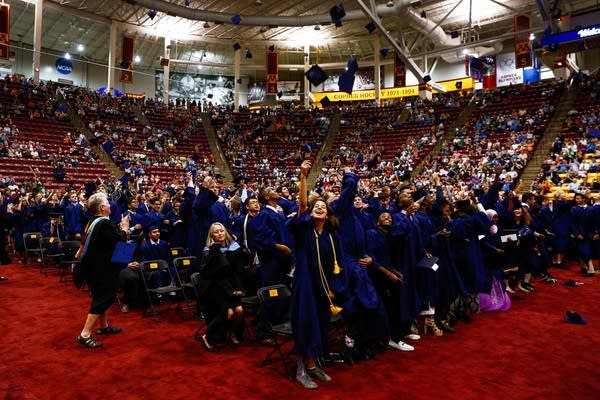Minnesota students graduating high school at historic rates

Go Deeper.
Create an account or log in to save stories.
Like this?
Thanks for liking this story! We have added it to a list of your favorite stories.
Updated: 4:52 p.m.
Graduation rates for Minnesota high school students are higher than they've ever been. That's according to data released Thursday by the state Education Department.
The class of 2019 hit a historic high of 83.7 percent — that's up half a percentage point from the year before and up nearly one and a half points over the last five years.
“I’m proud of all our students, educators and schools for again posting the highest graduation rate on record,” said Commissioner Mary Cathryn Ricker in a statement. “Reaching that high school graduation milestone is a pivotal moment on a student’s path to success.”
Black and Hispanic students made the biggest gains, with improvements of more than 3 percentage points for Hispanic students and more than two points for black students. The number of students dropping out of high school declined from 4.6 to 4.4 percent.
Turn Up Your Support
MPR News helps you turn down the noise and build shared understanding. Turn up your support for this public resource and keep trusted journalism accessible to all.
But racial and socio-economic disparities persist. Graduation rates are still higher for white students than they are for students of color.
And the rate for Native American students fell slightly this year. It remains the lowest among Minnesota's high school students, at just over half.
“These gaps in our graduation rates are unacceptable. Students of all races and ZIP codes deserve the same opportunity at achieving the life they have always dreamed,” Ricker said in her statement.
Although graduation rates are going up, Minnesota test scores are not. They’re stagnant or falling.
According to the most recent state test scores from the Minnesota Comprehensive Assessments, only 53.9 percent of students met or exceeded state standards for math proficiency in 2019. In 2016, close to 60 percent of Minnesota students met or exceeded those standards.
Reading scores in Minnesota also fell. Just over 58 percent of Minnesota students met state standards for reading proficiency this year — down from approximately 59 percent last year.
Still, graduation rates and test scores measure very different things. The Minnesota Comprehensive Assessments measure whether students meet grade-level standards. A high school diploma measures whether a student is meeting school and state requirements for graduation.
Julie Sweitzer, executive director of the College Readiness Consortium at the University of Minnesota, said more Minnesota students graduating is definitely good news.
“I think the increase in graduation rates is a reflection of over a decade’s worth of work by schools in response to accountability measures,” Sweitzer said. She also pointed to schools “finding lots of little and big ways to work with students to make sure they do get that high school graduation.”
She also pointed to successful strategies, like schools’ focusing on students in ninth grade, monitoring their progress and providing them with support early. She also said it was important for schools to be more aggressive about working to get dropouts back in school.
Commissioner Ricker said the gain in graduation rates was the result of schools’ focusing on social-emotional learning, building relationships with students and cultural responsiveness.
She said this was apparent especially in those schools that saw a higher-than-average graduation rate for Native American students.
“One of the things we’re noticing is that a number of those highest-performing schools engage in regular formal consultation with our tribal nations,” Ricker said. “Our working theory is that establishing this kind of partnership and shared responsibility is paying off in better meeting the needs of our Native students.”
Other organizations have also been working on bringing up the graduation rate and closing Minnesota’s education gaps. Michelle Walker is executive director of Generation Next, which is a nonprofit working to close achievement gaps in the Twin Cities. She said schools’ intentional efforts to monitor ninth graders and provide them the support they need to graduate is starting to pay off. But she also said there’s still a lot of work to do.
"It's not enough to just celebrate the high school graduation rate,” Walker said. “We also have to make sure that we are preparing early so children are entering early childhood experiences and that we're supporting them while they're in kindergarten through high school to make sure that they're prepared for what they need to do."



